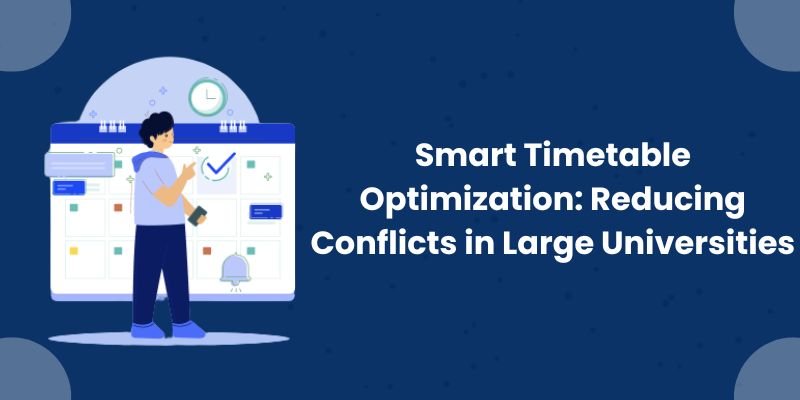Creating a timetable at a large university? That’s no small task. You’ve got thousands of students, hundreds of faculty members, limited classrooms, and course choices that overlap like a tangled web. And when even one piece of that puzzle shifts, the whole thing can fall apart.
Timetable conflicts are more than just an administrative headache. They affect students’ learning, faculty workload, and the smooth running of the entire campus. That’s why more universities are turning to smart timetable optimization.
With the right tools, built on automation, AI, and real-time data, you can stop playing calendar Tetris and start focusing on what really matters: education. In this post, we’ll walk through what smart timetable optimization is, why it’s so effective, and how companies like VAPS quietly make life easier for everyone involved.
What Is Timetable Optimization?
At its core, timetable optimization is about making the best use of limited resources, classrooms, time slots, faculty hours, and doing it without stepping on anyone’s toes. It’s about fitting all those moving parts together in a way that makes sense for everyone.
In a big university, you’re not just scheduling classes. You’re dealing with prerequisites, electives, student preferences, part-time instructors, lab slots, and even campus-wide events. Trying to juggle all that manually? It’s asking for trouble.
Smart optimization tools do the heavy lifting for you. They use algorithms to check for overlaps, find patterns, and generate balanced schedules that meet academic goals and logistical realities.
Where Things Usually Go Wrong
Let’s be honest, traditional timetabling often feels like guesswork. Even with the best intentions, conflicts pop up everywhere.
Student Clashes
The most common issue? Students enrolling in two must-have courses, only to find they’re scheduled at the same time. It’s frustrating, and it can delay graduation if not resolved quickly.
Faculty Overbooking
It happens more than you’d think. A professor is asked to teach two classes in two different departments… at the exact same time. Without proper visibility across departments, these overlaps sneak in easily.
Classroom Chaos
Sometimes two classes are booked into the same room. Or a class with 100 students is crammed into a space meant for 30. Other times, a huge auditorium sits empty for hours. Not a good look.
Poor Course Flow
Courses that need to be taken in a sequence get slotted out of order. Students end up waiting an extra semester or year to take what’s supposed to come next.
Demand Mismatch
Electives everyone wants fill up fast and get put in rooms too small to handle the interest. Meanwhile, under-attended courses take up prime time slots and large lecture halls.
How Smart Scheduling Tools Fix It All
Here’s the good news: smart timetable optimization systems are designed to spot and solve these issues before they happen.
These tools look at your entire course catalog, student enrollments, faculty availability, and room inventory. Then they piece it all together into a schedule that actually works.
And they don’t just build it once. If something changes, let’s say a professor takes unexpected leave or a classroom becomes unavailable, the system can quickly suggest updates without starting from scratch.
Another benefit? Integration. Smart systems pull data directly from your ERP, student records, and even attendance systems. That means no double entry, no outdated info, and no surprises.
Some tools even use AI to predict things like course popularity and peak classroom usage. That’s a game-changer for planning.
Everyone gets access to the latest timetable, too. Students can check their schedules from their phones. Faculty can get alerts about changes. Admins can pull reports instantly. No more endless email chains or last-minute phone calls.
What Makes a Timetable Tool “Smart”?
To really make a difference, a timetable solution has to do more than just spit out a grid of classes.
It should generate schedules automatically based on academic rules and available resources. Manual tweaking should be simple – ideally drag-and-drop. And if there’s a conflict? The system should flag it right away.
Resource management is key. The tool should match room sizes to class sizes, keep track of equipment needs, and help you avoid double bookings.
Integration is a must. It should work seamlessly with your ERP, learning systems, and staff portals. That way, changes in one place show up everywhere.
Mobile access matters too. Everyone, from deans to students, should be able to view and share the latest version of the timetable, anytime.
And because things change, it should keep a full version history. That means you can always go back if needed.
So, Who Benefits from All This?
Everyone.
Students get clear, conflict-free schedules. They don’t have to choose between two classes they need. They know where to go and when. That kind of stability makes it easier to focus and stay on track academically.
Faculty get well-balanced workloads and predictable schedules. They aren’t pulled in two directions or surprised by last-minute changes. That leads to better-prepared lectures and less stress overall.
Administrators save time and lots of it. They don’t have to manually check for overlaps or make endless calls to coordinate changes. Instead, they get reliable, data-driven schedules and the ability to fix issues fast.
Why Large Universities Can’t Afford to Skip This
When your institution serves thousands or tens of thousands of students, complexity multiplies. One small error can affect hundreds of people. That’s why automation isn’t just helpful. It’s necessary.
Manual timetable planning takes weeks. Often more. Even then, mistakes happen. When things go wrong, it creates frustration across departments and affects your institution’s reputation.
A smart timetable system reduces errors dramatically. It cuts planning time from weeks to days. It also adapts quickly to changes, which means less disruption during the term.
And in an era of hybrid and online learning, flexibility is key. Smart systems can handle mixed-format classes without breaking a sweat.
The Power of ERP in Timetable Management
Today’s ERP systems aren’t just about handling fees and student data. They’re becoming the digital brain of the entire institution.
A strong ERP can connect your timetable with every other academic function, course registration, attendance, faculty records, even exam scheduling.
So when a course is added or dropped, the ERP doesn’t just update one area- it adjusts everything automatically. No department is left out of the loop.
This centralization is critical. It saves time, prevents miscommunication, and ensures consistency across the board.
How VAPS Helps Institutions Stay Ahead
VAPS’ i-Vidyalaya is one of those solutions that understands what educational institutions need, especially when it comes to scheduling. Its timetable module isn’t just a side feature. It’s a thoughtfully designed tool that handles real-world complexity.
With VAPS, administrators can build full schedules in a few clicks. You can set unique rules for different departments, accommodate special requests, and still avoid conflicts.
Need to adjust a timetable mid-semester? No problem. VAPS syncs changes across your ERP and notifies the right people automatically.
It also connects to attendance tracking and room usage reports. That gives admins insights into how well resources are being used and where improvements can be made.
Plus, it’s mobile-ready. So whether you’re on campus or offsite, you always have the latest schedule at your fingertips.
Where Things Are Headed
The future of scheduling in education is going to be personalized and predictive. Systems will learn from previous years. They’ll recommend ideal course loads for students. And they’ll adapt in real time to changes in enrollment or staff availability.
Expect smarter dashboards, deeper analytics, and more collaboration between departments.
Universities that embrace this now won’t just be keeping up, they’ll be leading.
When timetables run smoothly, everything else does too. Classes start on time. Students attend the courses they need. Faculty teach without confusion. And administrators spend less time fixing problems.
Smart timetable optimization makes all of that possible. It replaces stress with structure. Chaos with clarity.
And tools like VAPS? They help make that shift seamless, quietly working behind the scenes to bring order to complexity.
If you’re still building schedules manually, now’s the time to rethink that approach. The right technology can turn timetable planning from a nightmare into a strength.












